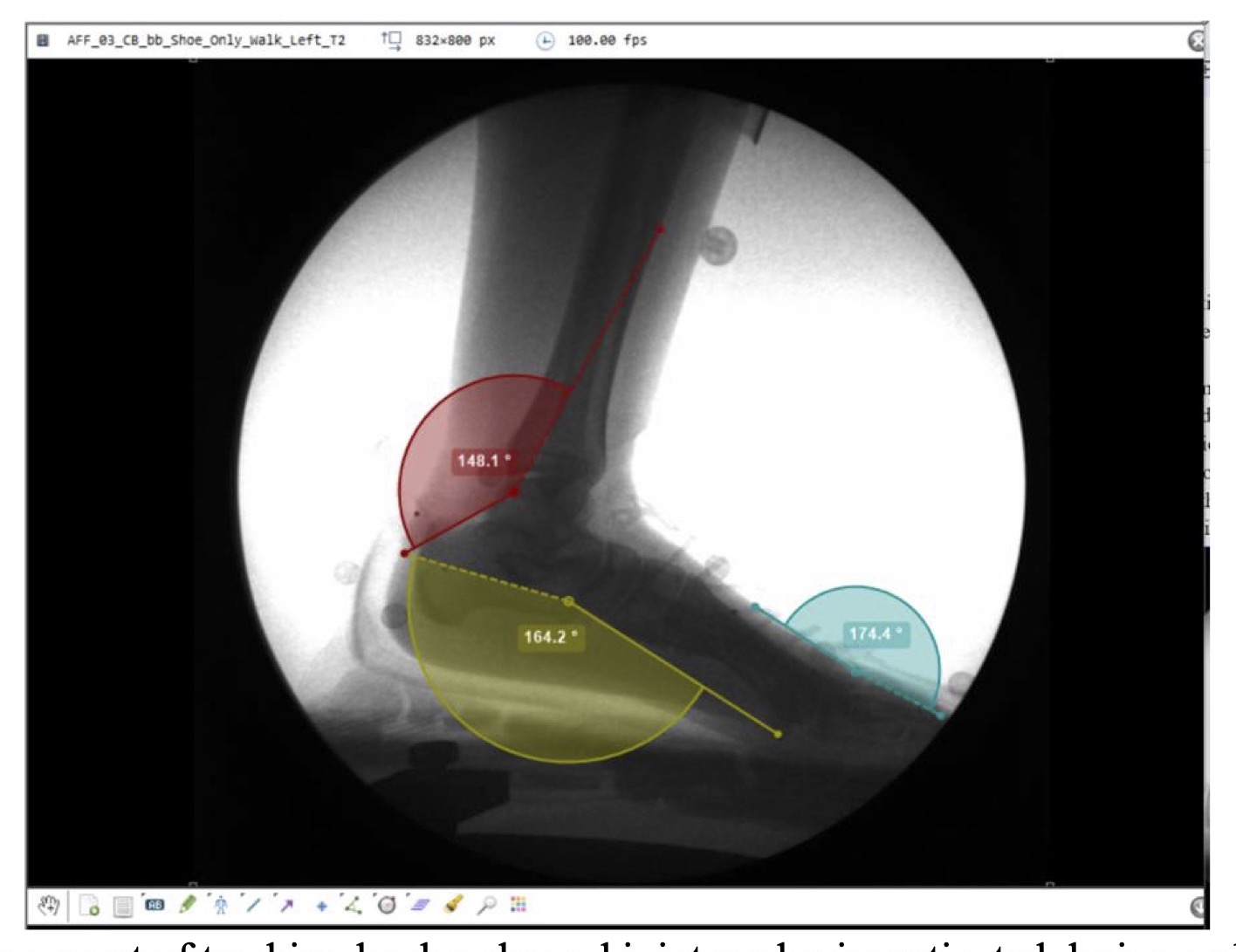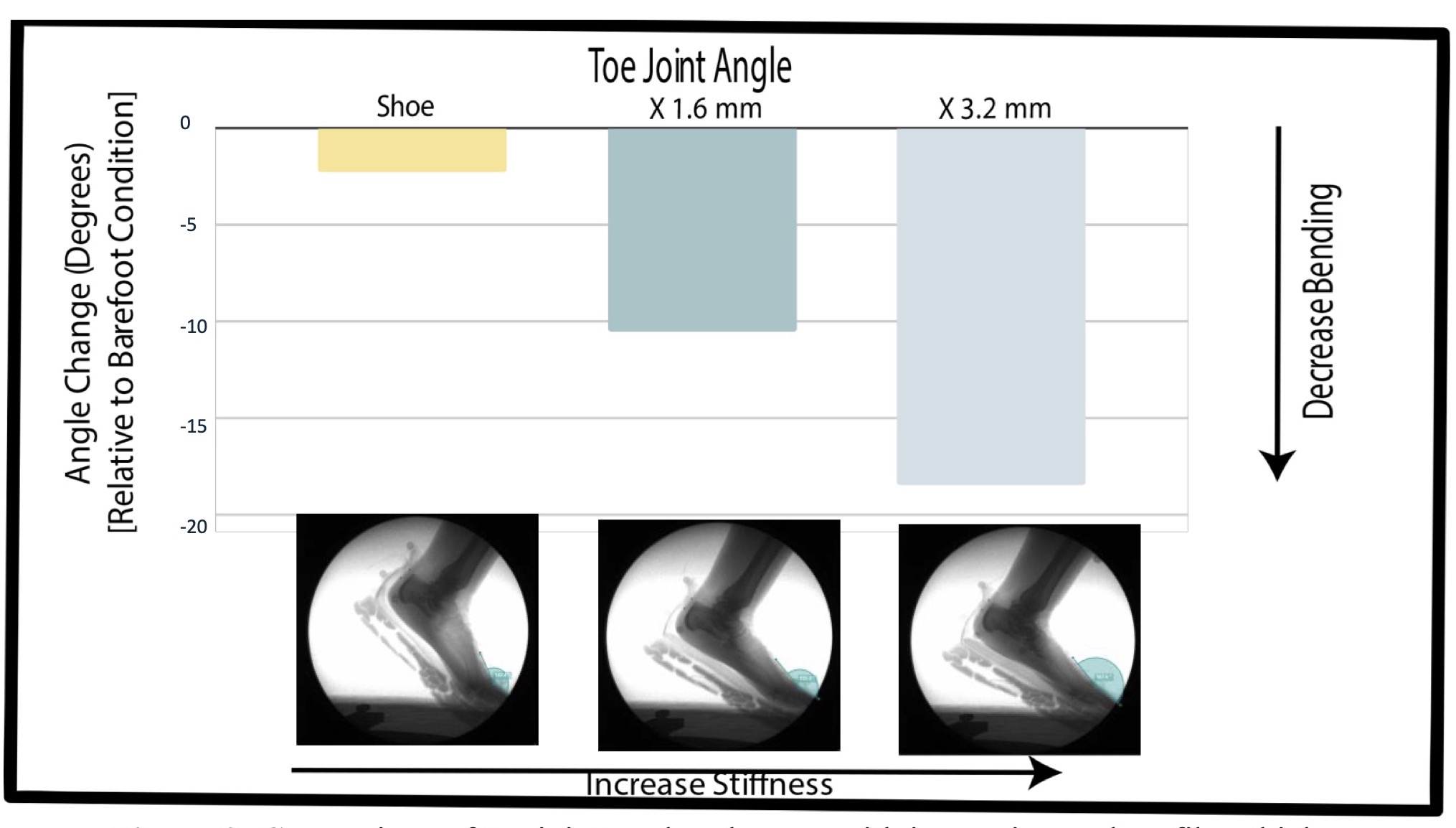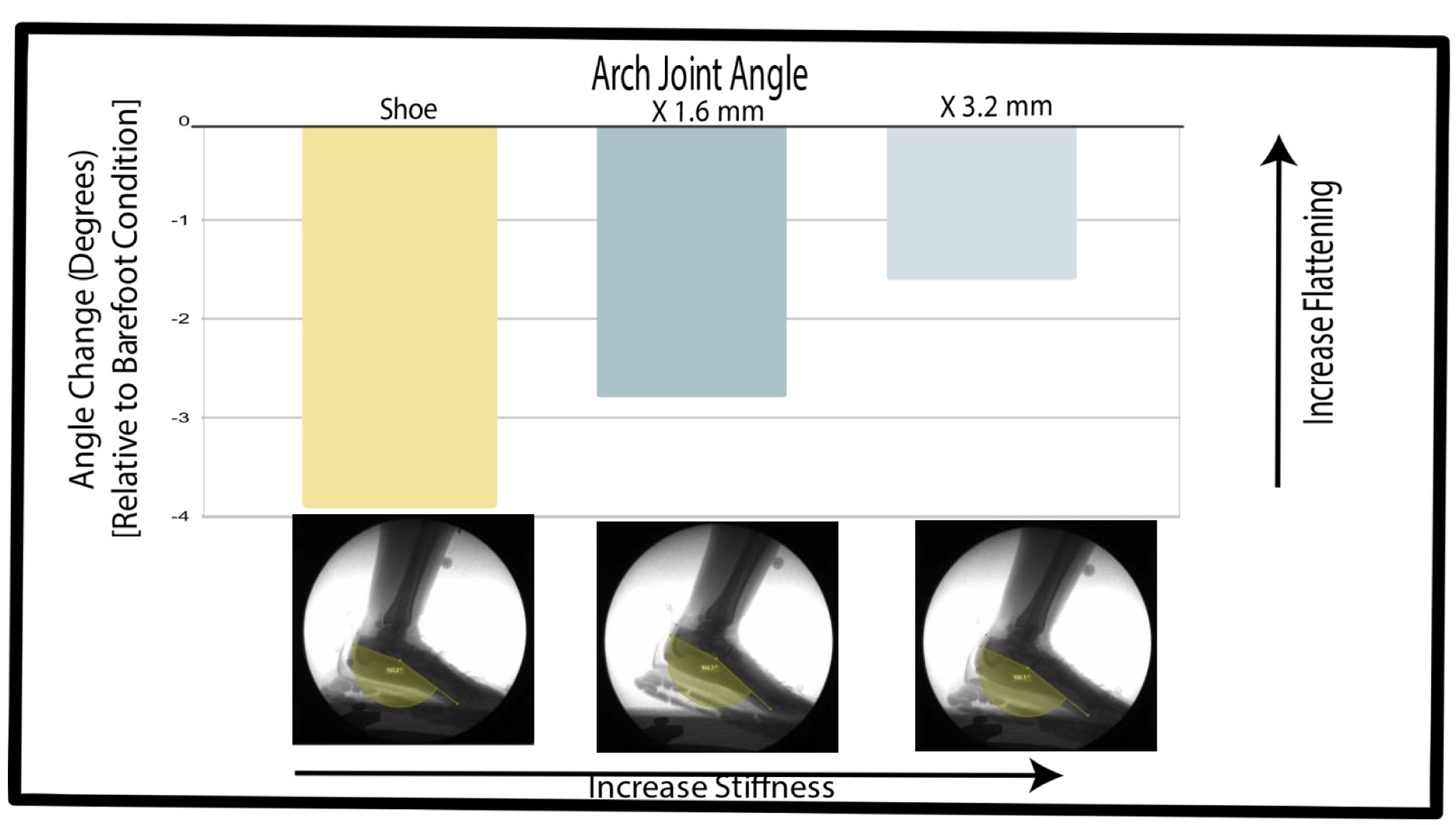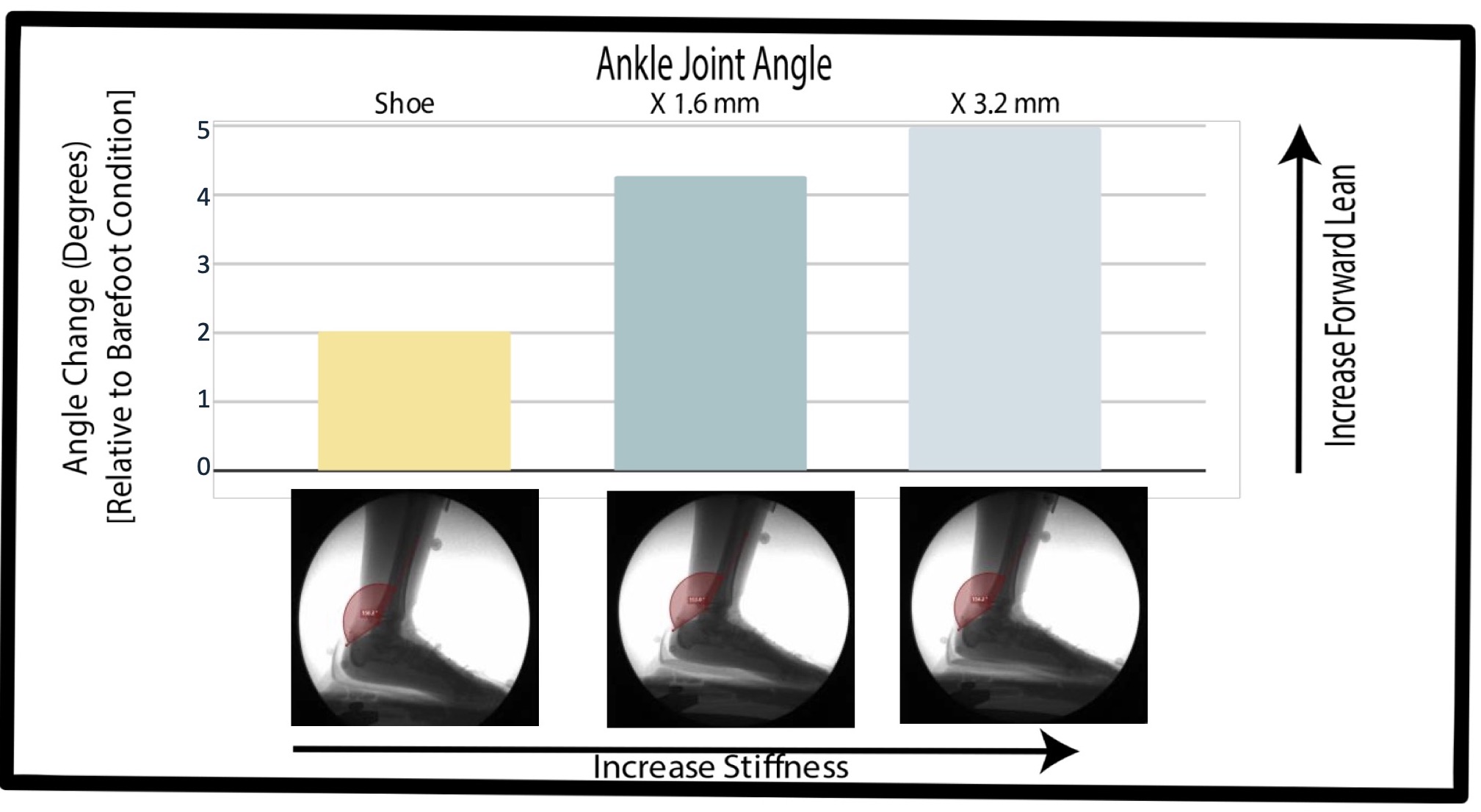College of Health
39 Effects of Different Thickness of Carbon Fiber Insoles on Foot Motion using X-Rays
Megan Weaver; Kota Takahashi; and Amy Lenz
Faculty Mentor: Kota Takahashi (Health, Kinesiology, and Recreation, University of Utah)
Abstract
Carbon fiber has been incorporated into high performance running shoes and found to reduce energy expenditure during running because of carbon fiber’s ability to act as an energy storage and release material. Outside of high-performance settings, the energy storage and return capacity of carbon fiber has many other clinical applications, including assistance with locomotion and foot mechanical limitations in the elderly, those with limited walking abilities, and everyday use, as carbon fiber may reduce the work done by the foot during locomotion. However, whether the energy storage and return capability of carbon fiber plates results in changes to the foot mechanics is largely unknown, as due to data collection limitations, the in-shoe foot mechanics when ambulating with carbon fiber insole has not been studied. Therefore, the purpose of this study was to determine how different thicknesses of carbon fiber changed foot joint angles during a typical walking gait cycle. We hypothesized that increasing shoe stiffness via carbon fiber insoles would cause the: 1) toe joint to decrease dorsiflexion [toe will bend less] 2) arch to decrease plantarflexion [arch will be flatter] 3) ankle to increase peak dorsiflexion [foot will increase forward lean]. Through the use of a biplane fluoroscopy (i.e., x-ray) system, bone motion was captured inside of the shoe to analyze foot joint angles. One participant (N=1, F, 21) walked across the biplane fluoroscopy under four different conditions: barefoot, shoe, shoe with 1.6 mm carbon fiber, and shoe with 3.2 mm carbon fiber.
Analysis of the joint angles for the metatarsophalangeal joint (i.e., toe), midtarsal joint (i.e., arch), and ankle were conducted through use of the Kinovea software. Overall, the results found comparing baseline Shoe vs Carbon 3.2 mm supported the hypothesis: 1) toe decreased dorsiflexion by 16.28° 2) arch decreased plantarflexion by 2.3° 3) ankle increased dorsiflexion by 2.96°. These results indicate that, at toe off, increasing the CF plate thickness resulted in a flatter foot at the toe and arch, but greater ankle dorsiflexion, potentially reducing work/energy requirements of foot through energy storage and release capability of the CF plate. The research utilized a novel state-of-the-art method via high-speed X-rays to analyze foot motion inside of the shoe during walking. This data is meaningful in helping further the development of footwear for people of all ages with the goal to reach new athletic records, walk with less energy requirement, and wear a more comfortable shoe.
Introduction
In recent years, carbon fiber (CF) has been slowly incorporated into many high-performance running shoes, e.g., Alphyflys, Vaporflys, and Carbon X. Many athletic shoe companies utilize the advantages of carbon fiber proven to reduce energy expenditure during running (Hoogkamer). Carbon fiber provides a stiff material property which acts as an energy storage and release material (Willwacher), helping to enhance the performance of athletes. Recent experiments comparing running shoes with standard versus CF insoles have found that the use of carbon fiber insoles significantly reduced the energy expenditure in elite athletes (Hoogkamer), and significantly increased the stride length, ground reaction force (GRF), and running speed in non-elite athletes (Reynolds). The improvement in performance metrics in both elite and non-elite runners indicates that CF insoles provide additional assistance and performance beyond that of standard running shoes, perhaps due to the energy storage and return property of CF.
Carbon fiber technology has shown to be an endurance performance enhancer, but limited research has been studied on population other than athletes or non-running activities. The advantages of carbon fiber should not be limited to runners, instead it should be applied to daily activities such as walking. By studying the effects of carbon fiber on walking, it allows a wider population range to utilize carbon fiber including the elderly. Older adults struggle to maintain faster walking speeds as they age due to natural causes. Their bones become less dense, cartilage that lines the joints tends to thin, and ligaments/tendons become less elastic, making the body less active and harder to walk(‘Aging’). Future research could use carbon fiber to enable non-athletes/elderly walk faster with less energy required, allowing them to keep pace better.
While we understand that CF insoles can reduce energy expenditure (Hoogkamer), it is unclear whether energy expenditure results in changes to foot mechanics within the shoes during locomotion. Due to limitations such as marker misplacement on the shoes during data collections, the assumption that the foot does not move relative to the shoe during gait, and other data collection limitations, the current technology standards may result in error within the estimated foot kinematics. Marker placement, on average, can be 2 mm off, with a high of 7 mm off from the desired location on repeated trial experiments (Bruening). To reduce the errors associated with marker misplacement, and to understand the movement of the foot more clearly within the shoe with a CF insole, a biplane fluoroscopy machine can be utilized. Biplane fluoroscopy, a real-time ‘X-Ray Movie,’ allows the continuous capture of data instead of a standard one photo ‘X-Ray,’ allowing repeatable, and accurate video data to be collected. The continuous capture of data can be utilized to eliminate the errors presented in marker placement and allow the bones inside of the shoes to be visualized, so that each trial can confidently choose the right segment to be tracked.
Our experiment investigated the effects of carbon fiber thickness on joint angles using biplane fluoroscopy. We hypothesized that increasing shoe stiffness via carbon fiber insoles would cause: 1) the toe joint to decrease dorsiflexion [toe will bend less] 2) the arch to decrease plantarflexion [arch will be flatter] 3) the ankle to increase peak dorsiflexion [foot will increase forward lean].
Methods
Our experiment examined different thicknesses of carbon fiber using the biplane fluoroscopy system. Carbon fiber thickness of 1.6 mm and 3.2 mm were cut to be inserted into the New Balance 880v13. These shoes provided the desired stiffness and comfort with their fresh foam cushion.
To evaluate the effectiveness of the carbon fiber, subjects were asked to walk across the X-ray machine under four different conditions: barefoot, shoe, shoe with 1.6 mm CF, and shoe with 3.2 mm CF. Each condition required three trials to help average inconsistencies formed during the ‘break-in’ period. ‘Good’ trials meant that the subject’s entire foot was in the frame during their typical gait cycle.
The subject was asked to walk at a comfortable, self-selected speed where a metronome was used to maintain a consistent pace during the duration of the experiment. This ensured that the change in joint angles came solely from the carbon fiber rather than stride frequency. The biplane fluoroscopy set to a sample rate of 100 Hz with a period of interest set right before heel leaves ground to right after toe off ensuring all three segments were in frame.
Kinovea, a 2D video annotation software, measured the joint angles. Each trial was uploaded onto the software where segment placement for the different joints were measured.
Joint angles of the metatarsophalangeal joint (i.e., toe), midtarsal joint (i.e., arch), and ankle were investigated, with joint angles defined as in Figure 1 and as follows. Metatarsophalangeal joint angle was centered at the dorsum of the 1st metatarsal head with endpoints at the hallux nail and dorsal surface of the base of the 4th metatarsal. Midtarsal joint angle was centered on the navicular bone with endpoints at the calcaneus on the Achilles tendon insertion and medial aspect of the 1st metatarsal. Lastly, the ankle was centered around the medial ankle with endpoints at the calcaneus on the Achilles tendon insertion and 2.5 inches above the medial ankle on the anterior tibia.

Figure 1: Placement of tracking landmarks and joint angles investigated during walking at self- selected speed with different CF insole thickness. Yellow: Metatarsophalangeal, Blue: Midtarsal, Red: Ankle
Measurements were placed to track the joint angle throughout their gait cycle to analyze each joint’s maximum dorsiflexion/plantarflexion. The metatarsophalangeal peak dorsiflexion angle was found right before toe-off with smaller angles indicating more dorsiflexion. Midtarsal peak plantarflexion occurs right after the heel leaves the ground. A greater angle formed between those joints means less plantarflexion and less of an arch. Ankle peak dorsiflexion occurs around the same time as the midtarsal joint, right after the heel leaves the ground, where a larger angle form indicates increased dorsiflexion experienced (increased forward lean).
Each condition measured all three joint angles, and trials were averaged together to determine how the carbon fiber influenced the joint angles. All trials were compared to the baseline barefoot conditions, where difference can be compared though.
Results
Notably, all three joint angles found changes as the carbon fiber thickness increased (Table 1, Fig. 2-4).
Table 1: Average joint angle (Difference from barefoot conditions) before toe-off during walking with different CF insole thickness

A positive value in parentheses indicates an increase in joint angle and negative value in parentheses indicates a decrease in joint angle relative to barefoot condition.
Each CF condition was compared to the barefoot condition, with the changes in the toe joint (Table 1, Fig. 2) during the shoe, 1.6 mm CF, and 3.2 mm CF to be -2.27°, -10.51°, and -18.5° respectively.

Figure 2: Comparison of toe joint angles changes with increasing carbon fiber thickness. Larger joint angle changes indicate decrease dorsiflexion or bending of the foot.
Following the same pattern of comparison, the midtarsal joint (Table 1, Fig 3) changed of – 3.9°, -2.8°, and -1.6 ° for the shoe, 1.6 mm CF, and 3.2 mm

Figure 3: Arch joint angles change over different conditions. Smaller joint angles changes indicate decreased plantarflexion or flattening of the foot.
At the ankle, the joint angle (Table 1, Fig. 4) changes, compared to barefoot condition, were 2.02°, 4.28°, and 4.98° for the shoes, 1.6 mm CF, and 3.2 mm CF condition.

Figure 4: Change in ankle joint angles with different thickness of carbon fiber. Larger joint angle change indicates greater dorsiflexion at the ankle.
Discussion
The study aimed to analyze how foot motion varies under different carbon fiber thicknesses using biplane fluoroscopy. This study provided the ability to see the bones inside the shoe allowing better tracking placement and a new innovative way to analyze joint angles.
All hypotheses were supported during this experiment. Results supported the prediction that increasing carbon fiber thickness will cause the toe joint to bend less, arch to become flatter, and the ankle to increase forward lean.
Toe joint angle decreased bending by 16.28° when comparing baseline shoe condition (degrees changed relative to barefoot condition) to the baseline 3.2 mm CF. The results matched previous studies where increasing the CF thickness led to a stiff toe joint which caused decreased bending while providing less energy expenditure (Hoogkamer). Our research supports the idea that increased carbon fiber stiffness results in reduced bending, and therefore may result in more efficient energy usage.
The foot arch was found to flatten by 2.3° when comparing baseline shoe and baseline 3.2 mm CF, supporting the hypothesis. The effects of carbon fiber on the midtarsal joint angle are unknown and limited studies have been conducted to analyze the impact. This research provides a baseline knowledge that stiff carbon fiber forces the arch to flatten trending towards the barefoot conditions.
Subjects walking during the barefoot condition experienced the flattest arch with the 3.2 mm CF having the second flattest arch. This indicates that the increased carbon fiber allows the arch to act more naturally as compared to shoes only conditions. The benefit of barefoot walking includes strengthening and tightening foot muscles, improving balance, better walking efficiency, and injury prevention. Since the carbon fiber allows the arch to act in a more natural barefoot way, it could provide all the benefits that barefoot walking offers.
The ankle joint angle was found to increase forward lean by 2.96° in the baseline 3.2 mm CF compared to baseline shoe condition, as carbon fiber thickness increased. Prior investigations on the effects of carbon fiber on the ankle found similar results (Ray). The study looked at different thicknesses of carbon fiber on walking speeds while measuring muscle activation. The stiff carbon fiber insole caused increased ankle dorsiflexion (forward lean) by 10% between low and high conditions (Ray). They concluded that the extra insole benefitted the foot-ankle system at faster speeds with a metabolic reduction of 7.1% (Ray). Our results could help further knowledge as to how the joint angle of the ankle changes and why it causes an energy reduction.
Significance
Using the biplane fluoroscopy system allows a massive barrier in biomechanics to be overcome by enabling accurate tracking of the bones within the foot. This innovative study allows foot motion to be visualized so more accurate and precise results can be found. Our results matched previous studies while giving new insight into the arch motion over the different thicknesses of carbon fiber.
Utilizing the information found provides a vital tool to analyze how joint angles are modified through carbon fiber, giving insightful information on what is favorable for performance, injuries, and shoe design. Previous knowledge is that carbon fiber reduces endurance athletes’ energy at faster speeds (Hoogkamer), and the information gained from our studies provides baseline knowledge as to how carbon fiber influences walking. Understanding how CF insoles change the foot mechanics may be useful in designing new innovative shoes for everyday use, with the goal would be to create shoes using carbon fiber that reduce energy at comfortable walking speeds for everyone. The elderly population could greatly benefit from these shoes where walking speeds that once were considered ‘hard to maintain’ could become comfortable and manageable. Future carbon fiber research could also help prevent injuries where modification of the carbon fiber could be made to create a shoe design that is most applicable for injury prevention.
Research knowledge gained from our study provides the ability to study foot motion in a new, exciting way. Biplane fluoroscopy allows researchers the tools to analyze bone motion in ways never seen before, which gives the ability to create better shoes, enhance performance at all levels, and visually see how the foot changes to prevent injuries.
Acknowledgements: This work was supported by the University of Utah Office of Undergraduate Research. I want to thank my mentor, Dr. Takahashi, for allowing this innovative research to be conducted and for challenging my knowledge throughout this internship. In addition, I appreciate the advice and guidance I received from post-doc, Dr. Burnetts. Special thanks to the Orthopedics Department for the use of the biplane fluoroscopy, and Dr. Lenz and her grad students (Kassidy Knutson, Katina Cernucan, and Katee Anderson) for all their help!
Bibliography
“Aging: What to Expect.” Mayo Clinic, 3 Nov. 2022, www. Mayoclinic.org/healthy-lifestyle/healthy- aging/in-depth/aging/art-20046070.
Bruening, Dustin A et al. “Analysis of a kinetic multi-segment foot model. Part I: Model repeatability and kinematic validity.” Gait & posture vol. 35,4 (2012)
Hoogkamer, Wouter et al. “A Comparison of the Energetic Cost of Running in Marathon Racing Shoes.” Sports medicine (Auckland, N.Z.) vol. 48,4 (2018)
Ray, Samuel F, and Kota Z Takahashi. “Gearing Up the Human Ankle-Foot System to Reduce Energy Cost of Fast Walking.” Scientific reports vol. 10,1 8793. 29 May. 2020
Reynolds, Sophia R. Lauren M. Hastert, Nina M. Nodland, Ian R. Matthews, Brad W. Wilkins & Alexis D. Gidley (2023): The effect of carbon fiber plated shoes on submaximal running mechanics in non-elite runners, Footwear Science
Willwacher, Steffen et al. “Does specific footwear facilitate energy storage and return at the metatarsophalangeal joint in running?.” Journal of applied biomechanics vol. 29,5 (2013): 583-92. doi:10.1123/jab.29.5.583

